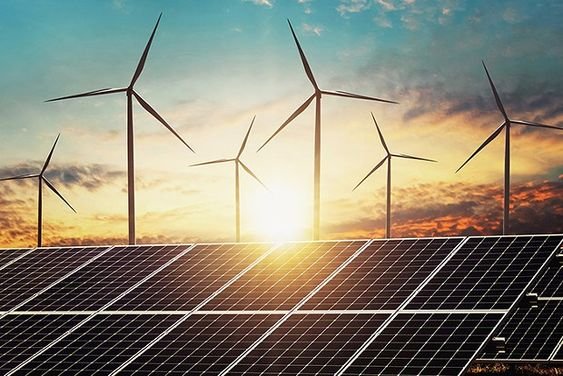
ABSTRACT
During the worldwide search for environmentally friendly energy sources, solar power technology is viewed as a bright spot because of its immense capacity to slow down global warming and lessen reliance on petroleum and coal for power. The overall sustainability of solar power technology is nevertheless severely constrained by the negative consequences of waste management and raw material extraction. This short attempt to give a summary of these difficulties is to highlight and take into account alternate ways to deal with them.
The procedure of extracting silicon, cadmium, along with tellurium-raw elements used in photovoltaic modules-may be harmful to the ecosystem as a whole. Deterioration of ecosystems and decreasing ecological diversity are frequently the results of mining activities, which also generate soil deterioration, contamination of waterways and destruction of habitats. Furthermore, the energy-consuming method for harvesting natural resources results in massive emission of carbon dioxide, which undermines the advantages of solar technology as a source of clean energy.
Possibilities to think about include producing photovoltaic cells that are also simpler to break down and reuse it, as well as promoting the development of alternative materials with a reduced ecological impact and better recycled procedures. The present research aims to examine the vital importance of photovoltaic technology in light of the imminent need to shift rapidly to renewable energy sources in consideration of worldwide warming concerns and the goal of minimizing reliance on limited resources like fossil fuels. It has also been pointed out since the use of renewable energy sources mises environmental dangers since it contains exotic substances like tellurium and dangerous metals like cadmium and lead. It is challenging to dispose of photovoltaic cells that include these materials as improper disposition might contaminate the environment as well as land.
Furthermore, governments everywhere have established together a number of programs and laws to deal with the ecological issues associated with the extraction of essential components and the elimination of waste in solar energy systems. To sum up, whereas the development of solar energy has enormous potential to create a greener and more secure the future, its ecological viability depends on how well the mining of raw materials and waste management are handled. Through the implementation for an all- encompassing approach which considers environmentally friendly variables at every phase of the photovoltaic panel’s life, researchers might maximize solar energy’s possibilities without reducing its negative ecological impact.
Keywords:
Solar Power Technology, Ecosystem, Photovoltaic cells, Ecological Viability
INTRODUCTION
The energy needs of mankind have always been evolving and increasing. Since the inception of human civilization, humankind has created tools and developed technology to make their life easier and win over the forces of nature. In its this endeavor, the requirements for energy as only increased exponentially. Further with advent of industrialization, and urbanization the demand for energy for domestic as well as commercial pulses has sky rocketed. However, the method of power generation has not evolved at the same pace. Although it is known fact the sun is the sole and the largest source of energy for earth, its importance and potential was realized once again in mid 1970s when, the world start experiencing global warming.
Global warming induced by its very own policy of unplanned and unregulated industrialization and urbanization which wreak havoc on the environment. During, 1970s suddenly the world observed extinction of species, depleting fossil fuels reserves, rising sea levels etc. an immediate threat to mankind was felt, which led to the shift towards a cleaner, sustainable and environment friendly energy source.
Hence, the world pivoted to solar energy. Solar energy however, required specialised solar technology, that could not only harness but channel and store huge gigawatts of solar energy that could be judiciously used for mankind. This technology has relatively newer, and comes with its own pros and cons. While the concept of harnessing clean and sustainable solar power is environment friendly, the technology used and the methods adopted, have not tested true to the litmus of eco-friendliness. Thus, this study aims to understand and critically analyze, whether solar technology is genuinely environment friendly or whether solar power generation I also a threat to the environment.

ANALYSIS
Need and growth of solar technology
The use of solar technology, refers to harnessing the everlasting and omnipresent Sun’s heat in various forms to meet the energy needs of mankind. As it may be presumed by many that use of solar energy or technology is a rather new or contemporary technique, however it has been using since ancient times. In ancient times is countries like Egypt, Athens and Greece, Solar cookers were used to cook food. Basic reflective materials such as metals and mirrors were arranged strategically to trap sun’s heat and bake food. Similarly, reflective materials were placed at rooftops of houses of elite class to heat water for warm baths. Not only that, a method of solar distillation was used in semi-arid or coastal areas where freshwater sources were not available, people built solar stills-simple devices consisting of a transparent cover over a basin of water to evaporate and collect clean water vapor condensation. Solar distillation provided a sustainable and energy-efficient solution for obtaining safe drinking water in areas where traditional water sources were search or contaminated.
Thus, the mankind has been using solar technology from the onset of civilization. However, its need was once again felt after the world witnessed the aftermath of industrial revolution. The industrial revolution brought with itself the practices of using fossil fuels exhaustively. It starting making and breaking economies, political ties reasons for waging wars etc. the country which harness and burn as much fossil fuels could run faster in the race of industrialization. Unfortunately, those practices were not sustainable and the environmental effects of such practices were soon to be borne by all. In the later of the 20th century, world started witnessing effects of climate change, fresh water reserves drying up rapidly, frequent droughts, and most importantly the greenhouse effects.
Thus, bring of fossil fuels had significant environmental, public health, and socioeconomic 22 effects, highlighting the importance of transitioning to cleaner, more sustainable energy sources such as renewable energy and energy efficiency measures. Hence the value for cleaner, affordable and inexhaustible energy resource was realized, which thus triggered the need for solar power generation and technology.
The following factors justify the need for solar technology –
Climate change- climate change mitigation is a pressing global concem, and solar technology
presents a sustainable and environmentally friendly solution to reduce relie on fossil fuels, the
main contributors to climate change. Solar panels harness solar energy to generate electricity
without emitting greenhouse gases, thereby aiding in the reduction of carbon emissions
associated with energy production and helping to alleviate the impacts of climate change.
Exhausting resources– The depletion of finite fossil fuel resources is a critical issue, necessitating the transition to renewable energy sources like solar power. Solar energy offers an abundant and renewable energy supply that can help offset the diminishing availability and escalating costs of fossil fuels, emphasizing the urgency of adopting sustainable alternatives.
Energy insecurity Enhancing energy security is another benefit of solar technology, as 15 it diminishes reliance on imported fossil fuels, thereby reducing vulnerability to geopolitical tensions and price fluctuations. Solar energy, being widely available across various regions, enables countries to diversify their energy sources and enhance resilience against supply disruptions and price instabilities. Cheap cost of production-The decreasing cost of solar technology in recent years has significantly enhanced its competitiveness with traditional energy sources. With continual price reductions and technological advancements improving efficiency, solar power is increasingly becoming a cost-effective energy solution for both residential and commercial applications. This affordability makes solar technology an appealing choice for consumers seeking long-term energy cost savings.
Eco friendly – Furthermore, solar technology not only aids in reducing greenhouse gas emissions but also contributes to environmental protection by minimizing air and water pollution associated with fossil fuel extraction and combustion. Solar energy production is clean and non-polluting, thereby helping to preserve ecosystems, biodiversity, and natural resources.
Job opportunities– The solar industry has emerged as a key driver of job creation and economic development, offering employment opportunities in manufacturing, installation, maintenance, and related sectors. The growing demand for solar technology presents significant prospects for job growth and economic advancement, particularly in regions with ample sunlight resources and supportive policy frameworks.
The inception of solar technology can be traced back to the mid-19th century when French physicist Alexandre-Edmond Becquerel discovered the photovoltaic effect, which laid the groundwork for the evolution of solar cells.1 Initially, solar cells were inefficient and costly, primarily utilized for specialized applications like powering telecommunication satellites and remote off-grid installations.2 However, advancements in materials science, engineering, and manufacturing processes have resulted in substantial enhancements in solar cell efficiency, durability, and cost-effectiveness. The competition between the United States and the Soviet Union during the space race in the 1950s and 1960s accelerated progress in solar technology, leading to the deployment of solar panels on spacecraft and satellites for power generation. These early space missions showcased the potential of solar energy as a dependable and sustainable electricity source, generating interest and investments in terrestrial applications.
Throughout the latter part of the 20th century, research and development endeavours concentrated on enhancing the performance and scalability of solar cells, resulting in the introduction of new materials and manufacturing methods. Silicon-based solar cells emerged as the predominant technology, offering high efficiency and reliability at relatively low costs. The oil crises of the 1970s further intensified interest in solar energy to decrease reliance on fossil fuels and address energy security concerns. Governments worldwide began investing in solar research and development, supporting initiatives to enhance solar cell efficiency, lower production costs, and encourage solar deployment.
The 21st century has witnessed a significant surge in the advancement solar technology, driven by a combination of technological innovation, cost reductions, and growing environmental consciousness. Breakthroughs in materials science, such as the innovation of thin-film solar technologies and perovskite solar cells, have broadened the array of solar cell choices and enhanced overall efficiency. Simultaneously, enhancements in manufacturing processes, automation, and economies of scale have led to substantial cost reductions in solar panel production, rendering solar energy increasingly competitive with traditional energy sources.
Government policies and incentives have also played a pivotal role in propelling the expansion of solar technology. Numerous countries have implemented renewable energy objectives, feeding tariffs, tax credits, and other financial incentives to promote investment in solar energy infrastructure and stimulate market demand. These policies have established a favorable regulatory landscape for solar development, attracting investments from both public and private sectors and fostering innovation throughout the solar value chain. Environmental Risks of Solar Technology Utilization of Hazardous Material in production.
The analysis of composition of solar cells in recent years has raised several concerns about hazardous materials and their recycling/disposal, even after 25 years. A significant majority of the solar cell technologies are using hazardous chemicals to achieve higher rate of conversion to electricity. The nature of the raw material generally determines the efficiency of conversion of the solar cells, panels and other products. The most efficient solar cells derive from single crystalline solar cells, which require humongous worklond and toxic chemical usage. Many hazardous materials are part of the manufacturing process of silicon used in the cells.

MINING
The mining extraction of raw materials for silicon-based PV: thin-film (TF) PV (CdTe, CIGS, InGaAs, etc.) and solar cells can also pave way to possible ecosystem, bodily health, and security 3. On a parallel note, rising solar PV production technologies such as organic solar cells and perovskite solar cells are also connected with health and environmental hazards, where there is lack of knowledge.
Moreover, the cells require are minerals like Bauxite, which require deep level mining at various areas covered with dense forests, thus affecting the flora and fauna along with the indigenous tribes of the region. For example, people have protested against mining of such rare-earth metals in Australia and Guinea where the mining has threatened the local ccosystems.
Regardless of the specific PV technology, PV can produce 89% more potential harmful air emissions per kilowatt-hour than conventional fossil fuels (Fthenakis et al., 2008; Fthenakis and Alsema, 2006; Mason et al., 2006). The creation of PV cells contains chemical dangers duct to the toxicity, corrosivity, flammability, and explosiveness of the materials used to create solar PV components.
Impact on water resources
Concentrating solar thermal plants (CSP), like all thermal electric plants, require water for cooling. Water use depends on the plant design, plant location, and the type of cooling system.
CSP systems using wet-recirculating technology with cooling towers use between 600 and 650 gallons of water every megawatt-hour of electricity generated. CSP facilities using once through cooling technology have higher water extraction rates but lower overall water usage (since water is not lost as steam). Dry-cooling technology can reduce water consumption at CSP facilities by up to 90%. However, the trade-offs for these water reductions are increased prices and reduced efficiency. Furthermore, dry-cooling technology is substantially less effective when temperatures exceed 100 degrees Fahrenheit.
Due to large parts receiving direct sunlight all through the year, India also faces the problem of water scarcity. Many towns and cities depend on groundwater for their agricultural and industrial needs. Without considering this aspect of water utilization in dry areas, such construction would not be just water depleting, but may also render the project’s feasibility a difficult level. Many of the regions in the United States that have the highest potential for solar energy also tend to be those with the driest climates, so careful consideration of these water tradeoffs is essential.

Waste Generation
India is expected to generate around 280 gigawatts of electricity through solar panels. International Renewable Energy Agency has stated in its annual report that by 2050, India is expected to produce 4.5-7.55 million tonnes of solar waste, making it the 4th highest generator of solar waste at that time4. This quantity is approximately 1.4 times the current amount e-waste generated in the country.
The statistics regarding solar waste are acted to expediate globally as it is expected that the domestic and industrial users of the technology may replace their panels with ones being innovated with better efficiency and lesser cost of generation. Future reduction in cost of replacement shall be a contributor to such replacement5. In simple words, if a solar panel is expected to last 25 years and around 40% users replaced the panels with upgraded versions after 15 years, then 40% waste is generated 10 years before the projected time.
Initiatives and policies of the government in this cause
As observed above, that solar power generation and solar technology generates huge amount of waste. According to a statistic, approximately 2.95 billion tons of solar panel waste consisting the solar panels and the balance of system will be accumulated from 2020 to 20476. Hence the solar technology poses a major threat, towards solar waste management in India in near future. In response the government of Indian has recently enacted the E-Waste management Rules (2022), according to which, the photo-Voltic cells and batters used in solar technology have also been covered under its ambit.
The policy thus, lays down the following-
7These regulations are to be followed for solar photovoltaic modules, panels, or cells, in accordance with the stipulations outlined in this section.
Manufacturers and producers of these solar products are required to:
- register on the designated portal,
- appropriately manage and store waste generated by solar photovoltaic modules, panels, or cells until the year 2034-2035 as per guidelines established by the Central Pollution Control Board.
- submit annual reports in the prescribed format on the portal by the end of the relevant year up to 2034-2035.
- ensure that waste processing. excluding solar photovoltaic modules, panels, or oils, adheres to the prevailing rules and guidelines,
- maintain a distinct inventory of solar photovoltaic modules, panels, or cells on the portal, and
- adhere to the standard operating procedures and guidelines set forth by the Central Pollution Control Board. Additionally, recyclers of solar photovoltaic modules, panels, or cells are required to comply with the recovery of materials as specified by the Central Pollution Control Board8.
These rules are an initiative to regularize the generation and management of waste of the solar technology, however these are very vague and incompetent to tackle with the current situation.
CONCLUSION
Solar Technology for the generation is the need of the hour in order to tackle climate change by being an alternative to the conventional methods. But the existing technology has certain requirements that can degrade the land, soil and the water resources. This means that though the technology can reduce the impact in climate change, it san significantly contribute as a harmful pollutant. Due to its potential in electricity generation, governments and multinational companies are investing billions of dollars in such transition.
This transition can only be successful if result of such installations actuates the purpose, te., sustainable and emission-less electricity generation. If we do not work on improvisation or alternatives to harmful nature of the materials used or the waste disposal, then such mode would ade to be a burden on the ecosystem, thus losing the purpose of such resourceful transition. The government has formulated certain policies and initiatives in this concern, but the solution lices in implementation and further research and development.
The bright side of tackling this challenge are two-fold. Firstly, the challenge of waste management is not specific to solar cells and the scope has been over all types of waste especially e-waste. Solving the challenge would be hence, beneficial for all the sectors. Moreover, waste disposal can be considered as a business opportunity as recycling would rejuvenate the raw materials required for further production of cells/panels and so would raise a billion-dollar sector further contributing to sustainable growth.
Footnotes
- Solar Energy and the Paris Agreement, Jenks, https://green.org/author/jenks2026/ ↩︎
- Solar history: Timeline & Invention of solar panels, Luke Richardson, energysage. ↩︎
- S Sundaram B, Benson, Solar Photovoltaic Technology, Potential Environmental Impacts, Environment and
Sustainability Institute, University Of Exter, United Kingdom, 2016. ↩︎ - Stephanie Weckend, End of Life Management: Solar Photovoltaic Panels, IRENA, p.g.72, 2016. ↩︎
- Atalay Atasu, Serasu Duran and Luk N.Van Wassenhove, The Dark Side Of Solar Power, HBR, 2021. ↩︎
- Strategic overview of management of future solar photovoltaic panel waste generation in the Indian context,
Neelam Rathore, Narayn Lal Panwar, Sage journals. ↩︎ - Chapter 5 E-Waste (Management) Rules, 2022. ↩︎
- Ibid ↩︎




